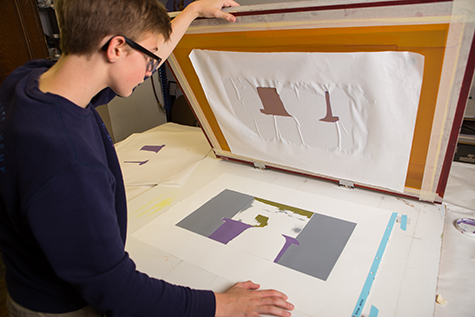The Necessary Guide to Understanding Screen Printing and Its Versatile Utilizes
Screen printing has a rich background that dates back to ancient times, progressing right into an advanced strategy utilized throughout different industries today. This overview explores the details of the screen printing process, describing its applications in fashion, advertising, and home style - 10:9 Design contact. Comprehending these principles can open creative capacity for both commercial and creative jobs. The adhering to areas will expose vital ideas and strategies to enhance one's screen printing endeavors
The History of Screen Printing
Although screen printing has origins that map back centuries, its evolution reflects the creative and technical improvements of various cultures. Coming from old China, the strategy was at first utilized for embellishing fabrics and later infect Japan, where it ended up being important to Ukiyo-e woodblock printing. The technique moved to Europe in the 18th century, where it gained appeal amongst craftsmens and business printers. The creation of photo emulsion in the 20th century reinvented screen printing, allowing for even more complex layouts and higher effectiveness. Artists like Andy Warhol even more drove its appeal, making use of the medium to produce iconic works that combined commercialism and great art. By the late 20th century, screen printing had established itself as a versatile technique, used in style, marketing, and fine art. Today, it remains to develop, incorporating electronic innovation and broadening its applications across various industries.
The Screen Printing Refine Explained
Screen printing changes artistic visions right into concrete layouts via a series of precise actions. An image is produced and after that moved onto a screen, normally made of fine mesh textile stretched over a structure. A light-sensitive solution is applied to the screen, which is revealed to light, solidifying in locations not covered by the picture. After cleaning out the unhardened emulsion, a pattern is formed.
Next, the screen is positioned over the substrate, whether it be material, paper, or another material. Ink is after that pushed through the open locations of the pattern utilizing a squeegee, transferring the style onto the substratum below. This procedure can be repeated for several shades, requiring different displays for each tone. The published item is treated making use of heat to guarantee the ink adheres effectively, resulting in a durable, vibrant layout prepared for usage.
Kinds Of Screen Printing Techniques

In addition, specialty methods, such as discharge screen printing, eliminate dye from the fabric to produce softer prints, while foil screen printing applies metal foil to attain a shiny surface (10:9 Design Company). Each technique supplies distinct features, accommodating different creative requirements and manufacturing scales, inevitably increasing the possibilities within the screen printing domain name
Applications of Screen Printing in Numerous Industries

Furthermore, the signs and marketing sectors use screen printing for developing captivating displays and banners. This method permits vibrant shades and elaborate layouts that record focus. In electronic devices, screen printing is used for using conductive inks to motherboard, visit this page important for component links. The home design sector welcomes screen printing to generate distinct designs on textiles and wall surface art. these details On the whole, screen printing works as an essential tool throughout varied fields, enhancing items with personalized and visually attractive graphics.
Tips for Successful Screen Printing Projects
While carrying out a screen printing job, cautious attention to detail can significantly improve the final result. Selecting high-quality materials is important; this includes the screen, inks, and substrates. Utilizing suitable mesh counts can affect ink deposition and information resolution. Preparation is equally crucial; detailed cleaning of screens and proper direct exposure times ensure crisp prints.
Next, accurate enrollment is essential for multi-color prints. Utilizing placement tools can help achieve exact layering. Furthermore, screening prints on scrap products before production helps recognize potential problems without losing resources.

Frequently Asked Questions
What Materials Are Ideal for Screen Printing on Textile?
Cotton and polyester blends are ideal for screen printing on textile because of their resilience and ink absorption. Additionally, specialty textiles like silk or canvas can generate distinct appearances and surfaces, fast sign printing improving the overall design top quality.
Just how Do I Clean and Maintain Screen Printing Devices?
To cleanse and preserve screen printing tools, one must on a regular basis wash screens with ideal solvents, inspect squeegees for wear, oil moving parts, and shop all products in a dry, dust-free setting to extend their life expectancy.
What Are the Ecological Impacts of Screen Printing?
Screen printing can have substantial environmental impacts, consisting of chemical waste from inks and solvents, water usage throughout cleansing processes, and power usage. Sustainable techniques and green materials are important for decreasing these unfavorable effects.
Can Screen Printing Be Done in your home Effectively?
Screen printing can be properly done at home with the best products and strategies. Enthusiasts can produce quality prints, though success depends upon their ability level, devices, and understanding of the procedure involved.
What Are the Prices Connected With Beginning a Screen Printing Service?

Beginning a screen printing organization involves costs for equipment, materials, and work space. First expenses usually vary from a couple of hundred to numerous thousand dollars, depending upon the range, high quality of machinery, and preferred production ability.
Screen printing has a rich history that dates back to old times, developing into an advanced method utilized throughout different markets today. An additional technique, rotating screen printing, utilizes cylindrical screens, assisting in continual printing on textile rolls, therefore boosting performance for large-scale productions. Additionally, specialized strategies, such as discharge screen printing, get rid of color from the material to produce softer prints, while foil screen printing applies metallic foil to achieve a glossy coating. In the style industry, screen printing is widely used to develop vivid designs on apparel, enabling brand names to display their special styles. Cotton and polyester blends are optimal for screen printing on material due to their toughness and ink absorption.